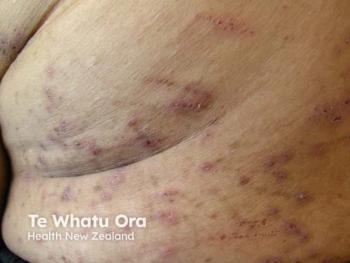
Hand dermatitis: Patch-testing could play predictive role
Patch-testing might be a helpful tool in determining individuals who may be at risk for developing irritant hand dermatitis, according to a recent study.
Key Points
Although dermatologists commonly patch test patients with allergic contact dermatitis, it's hardly routine in ICD, says Elma D. Baron, M.D., assistant professor of dermatology at Case Western Reserve University, Cleveland, and a study co-author.
"But based on our study," she says, "it seems as though patch testing might also be a helpful tool in determining individuals who may be at risk for developing irritant hand dermatitis."
Workplace dermatitis
"ICD continues to be a major problem in the workplace," Dr. Baron tells Dermatology Times.
In fact, the National Institute of Occupational Safety and Health considers workplace ICD a priority problem, she says.
All subjects completed a baseline questionnaire to assess their frequency of handwashing and use of alcohol-based cleaners and rubber gloves.
The questionnaire also asked participants about their history of specific medical conditions, such as asthma, allergic rhinitis/hay fever, urticaria/hives, atopic dermatitis/eczema, psoriasis and easy sunburns, as well as family histories of dermatitis or eczema.
Investigators then patch tested subjects, using various concentrations of sodium lauryl sulfate (SLS), sodium hydroxide (NaOH) and benzalkonium chloride (BKC).
Investigators assessed subjects for reaction at 24 hours, then monthly for six months. At each follow-up visit, investigators also re-examined subjects' hands for dermatitis and re-administered questionnaires to assess changes.
Overall, 60 subjects (58 percent) developed hand dermatitis at some point during the study.
"It was interesting to us that, somehow, positive results to patch testing with SLS and NaOH seemed to correlate significantly with the tendency to develop hand dermatitis among the population that we studied," Dr. Baron says.
In particular, 88 percent of subjects who reacted to SLS 2.5 percent developed hand dermatitis at some point (including their baseline visits), as did 64 percent of subjects who reacted to SLS 5 percent and 62 percent of subjects who reacted to NaOH 5 percent.
In contrast, the proportions of participants who did not react to these irritant concentrations but did develop dermatitis were between 31 percent and 36 percent.
The foregoing results were statistically significant (p=0.005, 0.019 and 0.029, respectively).
The highest concentration of SLS - 20 percent - showed no utility in predicting susceptibility to hand dermatitis, because it produced almost uniformly positive reactions.
Somewhat similarly, Dr. Baron says statistical analysis indicated that changing seasons did not skew results.
"We did not find any correlation between the other factors that we inquired about in our questionnaire," perhaps because the study's relatively small sample size couldn't capture this data, she says.
Another potential limitation involved investigators' empirical preselection of subjects who washed their hands at least eight to 10 times daily, Dr. Baron says, and it is possible that subtly different findings might have emerged if researchers had set a lower threshold, such as five handwashings per day.
At press time, researchers were analyzing blood samples from the same patient cohort to see if certain genetic polymorphisms correlated with development of hand dermatitis or sensitivity to patch testing.
Dr. Baron says she expects to complete this research later this year.
Newsletter
Like what you’re reading? Subscribe to Dermatology Times for weekly updates on therapies, innovations, and real-world practice tips.


















